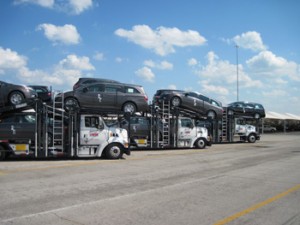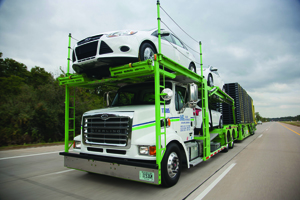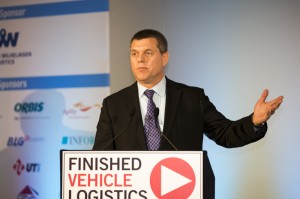The US car carrier business is busier than ever with high demand for capacity at short notice. Technology might have the answers but who will pay for it is another question.
 As the demand for capacity in the US car hauling business grows, transport providers are faced with a number of challenges. The main equipment makers, led by just two main providers – Cottrell and Delavan – are busier than ever. This is complicated even more by the sporadic issuing of requests for quotation (RFQs) by carmakers at short notice. Together these factors are affecting lead times for the delivery of the goods for service.
As the demand for capacity in the US car hauling business grows, transport providers are faced with a number of challenges. The main equipment makers, led by just two main providers – Cottrell and Delavan – are busier than ever. This is complicated even more by the sporadic issuing of requests for quotation (RFQs) by carmakers at short notice. Together these factors are affecting lead times for the delivery of the goods for service.
According to Tom Ogrodowski, business development manager at Brothers Auto Transport, the car industry differs from other sectors in that there is no steady stream of demand and consequently no opportunity for an even capital replenishment cycle.
“Here it comes in fits and starts, and the manufacturers themselves are all over the board with the exploration of contracts and renewals, and expansion opportunities,” he says. “Our planning horizons are very limited.”
Ogrodowski says that by March this year the company received three requests that surprised him since the operations in question were still under contract for at least another year.
It is an experience shared at Proficient Auto Transport. Brad Childs, vice-president for sales and operations, notes that order flows are up and down by the week and there is always a big push at the end of the business quarter. “Contracts become available unexpectedly and you are scrambling to find that equipment,” he says. “It is hard to keep up with demand when it fluctuates like that.”
Transport providers generally have between one and two weeks to process an RFQ and approximately 30 days to implement it, which puts pressure on getting the equipment turned around in time. In the end it can come down to a first come, first served situation.
Lead times on the delivery of transport equipment have been hit as a consequence and are now stretching out to four or five months in some cases.
“What really hurts is the limited number of trailer manufacturers,” says Childs. “If the demand is there to have the equipment that lead time gets longer.”
Specs versus demand
Car trailer design may be an exact science, but with the current level of demand – exacerbated by rail wagon capacity shortages – non-specific equipment is being used.
“Most of us have our specs together but as we all know, the market is getting busier,” says Bobby Hinton, vice-president of operations at Proficient. “Hopefully we will go back to what we used to do and that was ordering a piece of equipment for that particular business. Now everybody uses various pieces of equipment for all products and that isn’t the way it has been.”

According to Don Carney, CEO of Brothers Auto Transport, the demand for the best load factor means that the equipment has to be specific to purpose.
“We are always striving for the best load factor, like everybody else in the industry, and it takes a specific piece of equipment to create the best load factor you can in a timely fashion,” he says. “If we could go back to the mid to late 80s when they built all those small cars, and we could do the 14 car stacks like we used to, everybody would be happier, but those days are gone.”
Space, weight and materials
Getting the best load factor and optimising space on a trailer is a primary concern for Cottrell, but it is safety first according to its chief executive officer, Danny Zink.
Speaking at last year’s FVL North America conference, Zink said that once the safety aspect is accomplished, the next focus is on the optimisation of space and weight.
“[It is about] a combination of making the trailers lighter so they can haul more payload without jeopardising the structural integrity of the trailer and its durability,” said Zink. “That primarily centres around all kinds of different material studies. We continuously look at higher strength and lower weight steels, the real high strength alloys between 120-160psi. And then we look to incorporate those materials in places that will give us the biggest bang for the buck.”
Zink said that optimised space and durability were the two main perennial demands of the customer, which was closely tied to those material studies.
“That is different for different loads, so if they are hauling a load of heavy pick up trucks we will have a different strategy to one for hauling smaller fuel efficient cars,” Zink told delegates. “The study of materials is the biggest thing we use. We have a high concentration of aluminium where we can use it: special alloy steels, even composites at times in certain places. That is a continual thing for our industry.”
Cottrell declined to comment for this article.
Environmental regulation
Added to that pressure on weight and materials, environmental regulations are going to demand greater complexity in design and manufacturing of tractor units. In 2010, the US Environmental Protection Agency (EPA) and the National Highway Traffic Safety Administration (NHTSA) announced joint greenhouse gas emissions and fuel efficiency standards for medium- and heavy-duty engines and vehicles, applicable from model-year 2014. Further rulings are due in 2017 and 2020.

“I don’t think the technology is where it needs to be just yet. With the natural gas it has a huge tank on the back that takes up a lot of space. With car hauling every inch counts and if you take up that space it is a financial hit,” says Carney.
Hinton welcomed the idea but said that carmakers were unlikely to be willing to pay more for such technology.
The question of who pays for the demands for equipment development is a sticking point for transport providers, who remember the costs involved in the switch from chains to soft ties for securing vehicles that happened during the last decade.
“All the manufacturers want cheaper rates, so nobody ever paid for the conversion to the soft ties or for trucks with the soft tie built into it,” recalls Hinton. “When they first came out with soft ties in new trucks it was almost $30,000 per truck in additional cost to what we were dealing with.”
According to Hinton, providers cannot always take hits like that on the chin: “If they want autos to get to the dealership these days [OEMs] are going to have to pay the piper.”
“There was no pressure to move the rates up, so there was no return on that investment,” concurs Barry Williams, vice-president of operations at Hansen and Adkins Auto Transport. “That is why you don’t see new carriers popping up here, there and everywhere.”
The elephant in the room
That point is reiterated by Bill Pawluk, CEO of Convertible Trailer Manufacturers Worldwide (CTM). “There is no push by any specific OEM to support a strong rebuild and resupply initiative,” he says.

Pawluk maintains that the automotive logistics industry is spending $50 billion a year more than necessary worldwide because of inefficient transport and wasting 8 billion litres of fuel a year. Two separate fleets are used for inbound and outbound with 42% of car carrier journeys logged with empty trailers – the highest empty factor in the transport industry.
“If you can come in with some sort of engine innovation that is going to make the truck use less fuel, then that is fantastic, but the elephant in the room is the coming home part,” says Pawluk. “Why are you spending hundreds of millions on engine technology when the primary challenge should be using your equipment more efficiently?”
Scale and combination
Pawluk’s push to fill empty miles comes as little surprise, as CTM’s vehicle carrying trailers are able to collapse in a number of configurations to accommodate containerised cargo. He said the Convertible Trailer can ship 100% load factor outbound and can manage an 85% weight load factor for return shipments on the same rig. That return load factor can be 100% if weight is not a limiting factor. CTM has even designed its own container, called AutoBox, which is itself collapsible and can be used to carry any sort of automotive or dry components and can be loaded by forklift.
A similar collapsible and stackable container solution is provided by Hybrid Intermodal Transportation.
Convincing a North American sector that is short of capacity and wants its trucks back quickly may be a challenge, but Pawluk says that with the right scale and combination, that issue is easily addressed.
“By adding a small margin of auto carrier assets into the industry and using them more efficiently, such as filling them on their empty miles, you will have more flexibility and scale to handle the workload,” says Pawluk. “Your fleets will be safer as they are constantly producing revenue and not rushing back for their next trip.

Convincing the North American transport sector is one thing; lobbying for a change in US transport legislation, is another. Current car carrier regulations covering the US and Canada rule that you cannot haul other freight on the tractor portion of the stinger system but you can haul it on the trailer portion. Present legislation worded in the 1980s allowed carriers to put motor vehicles (including even camper vans) on the power unit. However, the Highway Administration has refused any further amendment at this time that would allow other freight. Further amendments must be approved by Congress and this effort is underway.
Nevertheless, Pawluk and his colleagues are continuing to lobby the administration. “If the legislation was approved three years ago we would have 1,000 trailers on the road today,” he says. “When that legislation is passed we will be selling trailers immediately because we know where the synergistic runs exist – where there is outbound product that can coincide with inbound automotive or general freight coming back to base. We know many of these routes exist.”
Meanwhile, as the industry in the US is potentially losing hundreds of millions of dollars, CTM is getting on with developments in a number of markets abroad. Importantly, it has just announced a tie up with Lohr Industries in France to manufacture and sell convertible trailers. The partnership will ship prototypes available by June, with trials to start over the summer. Pawluk and his partners at Lohr say that the partnership will be a global one, with the potential to use Lohr factories around the world.
Without support for investment buying equipment will continue to be a fraught process of weighing the pros and cons while balancing the books for the finished vehicle carriers. And without legislative change by the Highway Administration, there appears little incentive in making what investments there are in new and versatile equipment – an investment that could quadruple profit through improved load revenue. “Tell me who can’t figure this out,” concludes Pawluk. “It’s like watching it all in ultra-slow motion.”





































